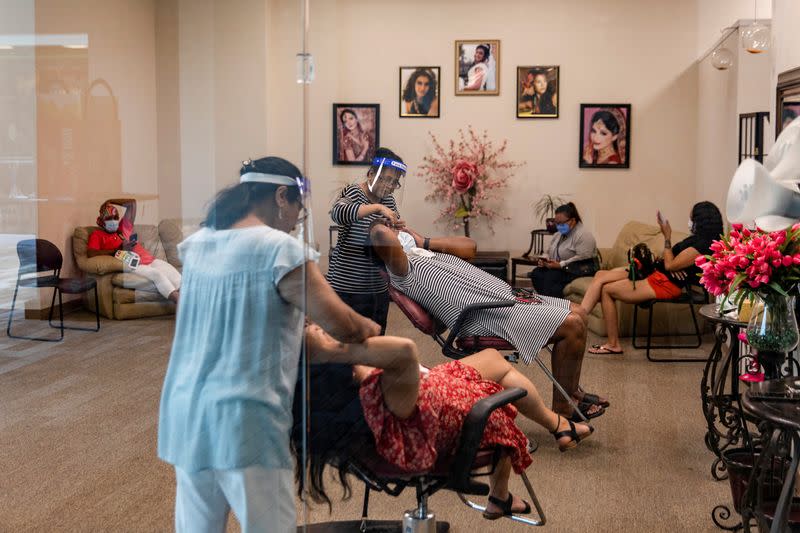Visits to U.S. stores, restaurants stall as concern over economic recovery grows
By Howard Schneider
WASHINGTON (Reuters) - Foot traffic to U.S. restaurants and stores showed little improvement last week, high frequency data show, and signs emerged of deepening stress for small businesses as economists worry the recovery from coronavirus lockdowns continues to slow.
After steady growth over the summer, estimates of seated diners at restaurants maintained by booking site OpenTable https://www.opentable.com/state-of-industry fell for the second week. They remain at about 60% of levels in early March before a national state of emergency was declared to combat the spread of the coronavirus.
Graphic: Retail in real time Retail in real time https://graphics.reuters.com/USA-ECONOMY/REOPEN/yzdvxxyzlvx/chart.png
Employee records on 55,000 small businesses maintained by Homebase https://joinhomebase.com/data showed the number of people working declined for a second week in a row.
Data from cellphone tracking firm Unacast https://www.unacast.com/covid19/covid-19-retail-impact-scoreboard shows that the gradual return to restaurants, gyms and other "close contact" businesses has largely stalled following improvement over the summer.
Graphic: Employment in real time Employment in real time https://graphics.reuters.com/USA-ECONOMY/REOPENING/gjnvwxamxpw/chart.png
Many U.S. businesses tapped federal programs for help early in the pandemic, but with the health crisis now likely to extend into next year, the stress may be too much.
Recent surveys from small business networking group Alignable and online review site Yelp both suggested a looming jump in small firm failures.
"The impact has been too deep for too long. And it's taking its toll," Alignable spokesman Chuck Casto said, after the group's poll of more than 6,300 small businesses, released Wednesday, found more then 40% expect they won't earn enough revenue through the end of the year to stay in business.
That finding is consistent with recent U.S. Census surveys of small businesses showing a decline in September in the percentage of firms that had enough cash on hand for more than a month of operation.
The fate of the United States' roughly 6 million small businesses will shape the broader contours of the recovery and the economy that emerges after the pandemic.
It will be particularly critical to sustain job growth. U.S. firms with fewer than 500 workers employed around 60 million as of 2017, according to Census data.
Some economic policymakers worry that the larger-than-expected job gains from May through August will mark the high point of the recovery. The economy clawed back about half of the 22 million positions lost in the spring's pandemic shut down, but few expect that pace to continue. Jobless claims unexpectedly increased https://ca.reuters.com/article/us-usa-economy-idCAKCN26F249 for the week ending Sept. 19, Labor Department data released Thursday show.
After hitting a pandemic-era high of 14.7% in April, the unemployment rate fell to 8.4% in August. But at the most recent Federal Reserve meeting even the most optimistic policymaker projected slower improvement, with the rate still 6.5% by year's end. The median projection called for less than a percentage point improvement from here.
New weekly job postings aggregated by economic consulting firm Chmura http://www.chmuraecon.com/blog from online employment firms and company websites have remained at roughly 90% of their pre-pandemic level in recent weeks - a sign of steady but not surging momentum in hiring.
By some high frequency measures, however, the economic rebound continues apace [nL1N2FM0JX]. Data from cellphone tracking firm Safegraph https://www.safegraph.com/dashboard/covid19-commerce-patterns showed foot traffic at retail locations overall is near its March level.
Sectors including manufacturing and housing have made steady progress. Data from time management firm UKG https://www.kronos.com/about-us/newsroom/update-us-workforce-activity showed that shifts worked across a variety of industries grew an average of 1.1% weekly so far in September after that figure dipped as low as 0.5% in August.
But that data also showed a divided recovery. Shifts worked at manufacturing firms for the week ending Sept. 20 were just 1% below the average from January through March. Retail firms were down by 10%.
Larger firms are "starting to dramatically outpace smaller businesses," in terms of labor pickup, said Dave Gilbertson, vice president of strategy and operations at UKG, with firms above 5,000 workers adding shifts at a rate of 3% per week, while growth among firms with fewer than 100 employees was less than 1%.
Measures of the broader national recovery have shown no clear direction for several weeks. An Oxford http://blog.oxfordeconomics.com/topic/recovery-tracker economics index combining health, economic and social data for the last four weeks has remained at about 80% of January's level.
Graphic: Oxford Economics Recovery Index Oxford Economics Recovery Index https://graphics.reuters.com/USA-ECONOMY/OXFORDINDEX/rlgpdlnyepo/chart.png
As federal unemployment and other benefits start to diminish, "the situation isn't sustainable without stronger gains in employment," said Oxford chief economist Gregory Daco.
(Reporting by Howard Schneider; Editing by Heather Timmons and Andrea Ricci)

 Yahoo Finance
Yahoo Finance 

